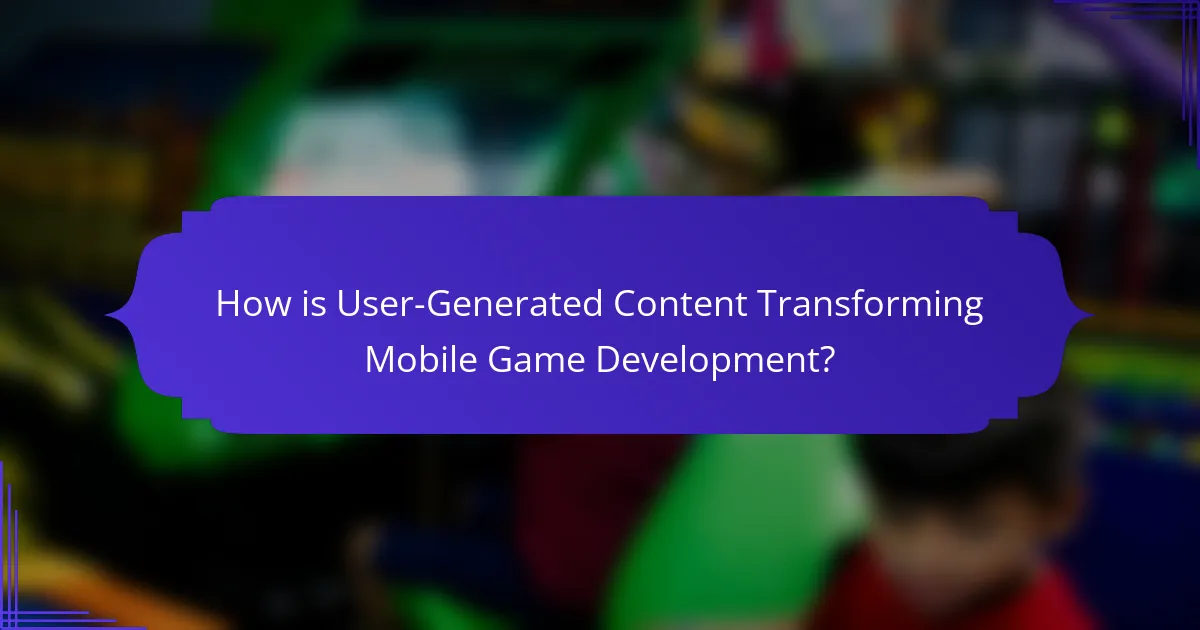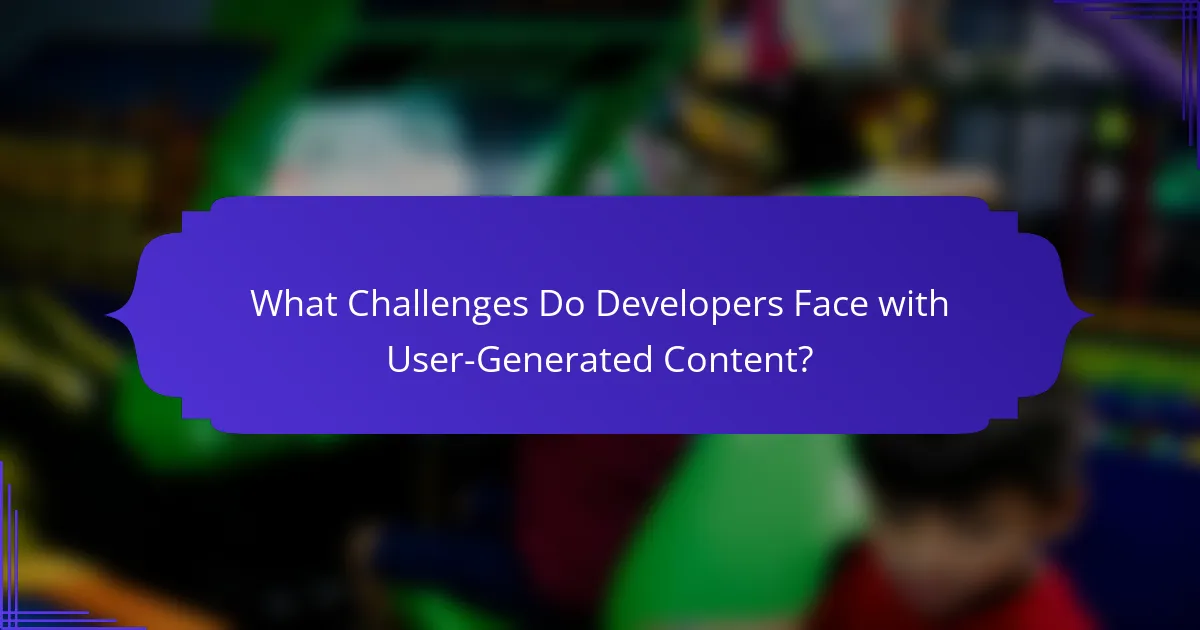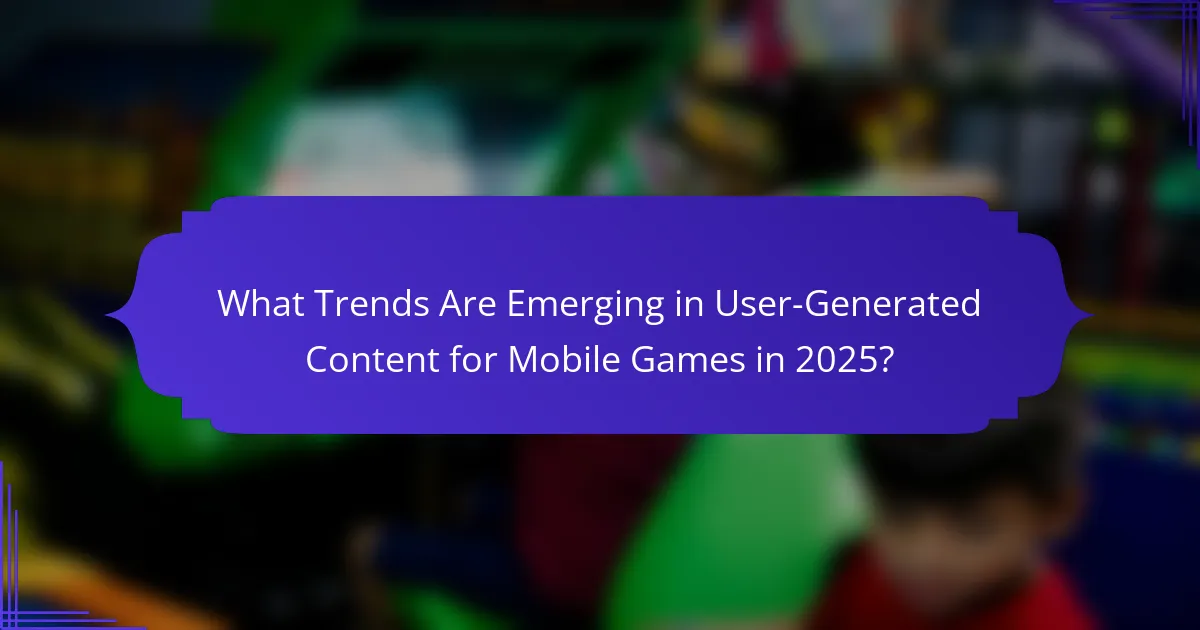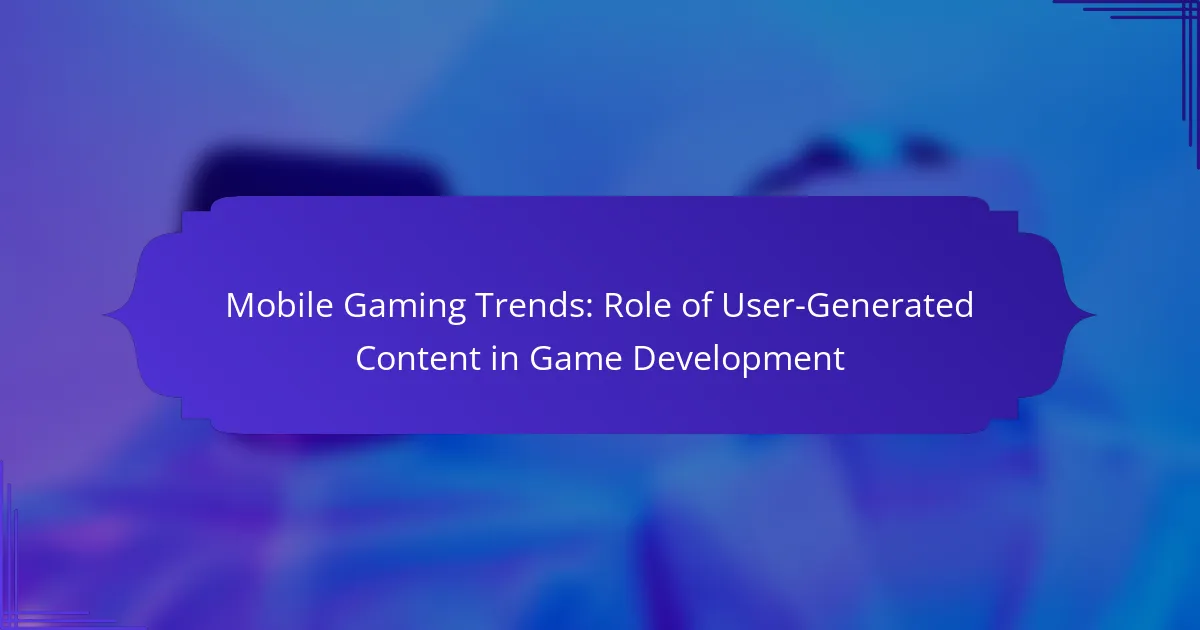User-generated content is transforming mobile gaming by enhancing player engagement and creativity. Key platforms like Roblox, Fortnite, and Minecraft lead in integrating user-created elements. This collaboration fosters community building and drives innovation, while developers face challenges in quality management and moderation. As trends evolve, user-generated content will play a crucial role in shaping personalized gaming experiences.

How is User-Generated Content Transforming Mobile Game Development?
User-generated content is revolutionising mobile game development by enhancing player engagement and fostering community creativity. Players contribute levels, characters, and storylines, allowing developers to leverage innovative ideas. This collaboration results in richer game experiences and extended longevity. User-generated content also reduces development costs, as it taps into the creativity of the player base. As a result, mobile games increasingly feature customisable elements, driving player retention and satisfaction.
What Are the Key Benefits of User-Generated Content for Developers?
User-generated content significantly enhances game development by fostering community engagement, improving player retention, and driving innovation. It allows developers to tap into player creativity, leading to unique game experiences.
1. Community Engagement: User-generated content creates a sense of ownership among players, encouraging them to contribute ideas and assets.
2. Improved Retention: Games that incorporate user-generated content often see higher player retention rates, as players remain invested in their creations.
3. Cost-Effective Innovation: Leveraging player-generated ideas can reduce development costs while introducing fresh concepts.
4. Enhanced Player Experience: Custom content allows for personalised gameplay, catering to diverse player preferences.
How Do Players Contribute to Game Design and Mechanics?
Players significantly shape game design and mechanics through feedback and user-generated content. Their insights help developers refine gameplay, enhance engagement, and introduce innovative features. This collaborative approach fosters a dynamic gaming environment where user creativity drives trends. For example, platforms like Roblox and Fortnite thrive on player contributions, allowing users to create unique experiences that influence overall game mechanics. As a result, developers can adapt quickly to player preferences, ensuring games remain relevant and enjoyable.

Which Platforms Are Leading in User-Generated Content Integration?
Platforms leading in user-generated content integration include Roblox, Fortnite, and Minecraft. These platforms empower users to create and share game content, enhancing engagement and creativity. Roblox allows extensive customisation with user-generated games and assets. Fortnite integrates user content through creative modes and community events. Minecraft supports modifications and custom worlds, fostering a vibrant user community.
How Do Mobile Platforms Differ in Supporting User-Generated Content?
Mobile platforms differ significantly in their support for user-generated content, impacting game development. iOS typically offers a more controlled environment, limiting certain types of content and ensuring higher quality standards. Android, on the other hand, promotes flexibility, allowing a wider range of user-generated content but may struggle with quality control. This difference affects developers’ strategies, as they must tailor their content creation tools and community engagement practices to fit each platform’s unique attributes. For example, iOS might emphasise curated content while Android supports broader user creativity.
What Are the Most Popular User-Generated Content Tools Available?
The most popular user-generated content tools available for mobile gaming include platforms that facilitate player engagement and creativity. These tools enhance game development by allowing users to create, share, and modify content, fostering a vibrant gaming community. Examples include Roblox Studio, Dreams, and Fortnite Creative, which empower users to design unique game experiences. These platforms often feature intuitive interfaces and extensive resources, making them accessible to both novice and experienced creators.

Why Are User Engagement and Community Building Essential in Mobile Gaming?
User engagement and community building are crucial in mobile gaming as they enhance player retention and foster loyalty. Engaged users are more likely to participate in user-generated content, which drives innovation and creativity in game development. This interaction creates a vibrant ecosystem where players feel valued and connected. As a result, game developers can leverage user feedback to refine gameplay and introduce features that resonate with the community.
How Can Developers Foster a Thriving User Community?
Developers can foster a thriving user community by actively engaging users and encouraging their contributions. User-generated content enhances the gaming experience, providing players with a sense of ownership and belonging.
Encouraging feedback through forums and social media creates a dialogue that can inform game development. Regularly incorporating user suggestions into updates strengthens community ties and loyalty.
Hosting contests or challenges that invite users to create content fosters creativity and investment in the game. This approach not only generates fresh content but also showcases the community’s talent, enhancing the game’s appeal.
Finally, recognising and rewarding top contributors builds a positive feedback loop, motivating more users to participate. By prioritising user engagement, developers can create a dynamic and supportive gaming community.
What Role Does Social Media Play in User-Generated Content Promotion?
Social media significantly enhances the promotion of user-generated content in mobile gaming. Platforms like Instagram and TikTok allow players to share their gaming experiences, fostering community engagement. User-generated content, such as gameplay videos and fan art, boosts visibility and attracts new players. As a result, games often experience increased downloads and player retention. Social media acts as a catalyst for organic marketing, leveraging user creativity to enhance brand loyalty and community building.

What Challenges Do Developers Face with User-Generated Content?
Developers face challenges in managing quality, ensuring moderation, and fostering community engagement with user-generated content. Quality control is essential to maintain game integrity. Effective moderation is needed to filter inappropriate content. Community engagement drives creativity but can be difficult to sustain.
How Can Quality Control Be Maintained in User Contributions?
Quality control in user contributions can be maintained through clear guidelines and active moderation. Establishing a framework for content submission ensures consistency and quality. Regular feedback loops with users enhance content accuracy and relevance. Implementing automated tools can help identify inappropriate or low-quality submissions. Engaging a community of moderators fosters a collaborative environment for maintaining standards.
What Are the Legal Considerations Surrounding User-Generated Content?
User-generated content in mobile gaming raises several legal considerations, including copyright, intellectual property, and user agreements. Developers must ensure that user contributions do not infringe on existing rights. Clear terms of service should outline ownership and usage rights of user-generated content. Additionally, moderation policies are essential to prevent harmful or illegal content. Compliance with privacy laws is also crucial, especially regarding user data collection and usage.

What Trends Are Emerging in User-Generated Content for Mobile Games in 2025?
User-generated content will increasingly shape mobile game development in 2025 by enhancing player engagement and creativity. Trends include the integration of community-driven content, such as user-created levels and skins, which fosters a personalised gaming experience. Additionally, platforms will likely introduce tools for easier content creation, encouraging more players to contribute. The rise of social features will further amplify sharing and collaboration among users, creating vibrant gaming communities.
How Are Monetization Strategies Evolving with User-Generated Content?
User-generated content is transforming monetization strategies in mobile gaming by enhancing engagement and community involvement. Developers increasingly leverage player-generated assets to enrich gameplay and create unique experiences. This shift promotes user loyalty and drives in-game purchases, as players feel a sense of ownership and investment in the game.
Moreover, platforms are emerging that allow creators to monetise their contributions directly, fostering a sustainable ecosystem. As a result, revenue models are evolving beyond traditional purchases to include subscription services and revenue sharing based on user-generated content. This trend reflects a broader movement towards community-driven development, where user input shapes the game’s direction and profitability.
What Innovations Are Influencing the Future of User-Generated Content in Gaming?
Innovations like augmented reality, blockchain, and AI are transforming user-generated content in gaming. These technologies enhance player engagement and creativity, allowing users to create, share, and monetise their content seamlessly. For instance, augmented reality enables immersive experiences, while blockchain ensures ownership and authenticity of digital assets. AI tools assist in content creation, making it more accessible for users. As a result, these innovations not only shape game development but also empower communities to contribute meaningfully.
What Best Practices Should Developers Follow for Effective User-Generated Content Integration?
Developers should prioritise user engagement, moderation, and seamless integration when incorporating user-generated content in mobile games. Engaging users through feedback mechanisms enhances content quality. Implementing effective moderation ensures a safe environment. Lastly, seamless integration into gameplay fosters a cohesive experience.
